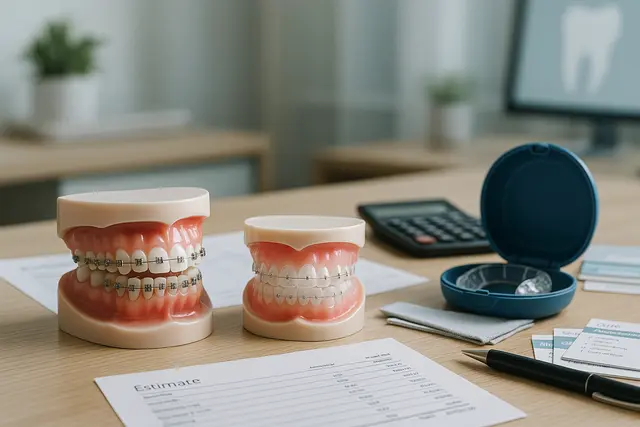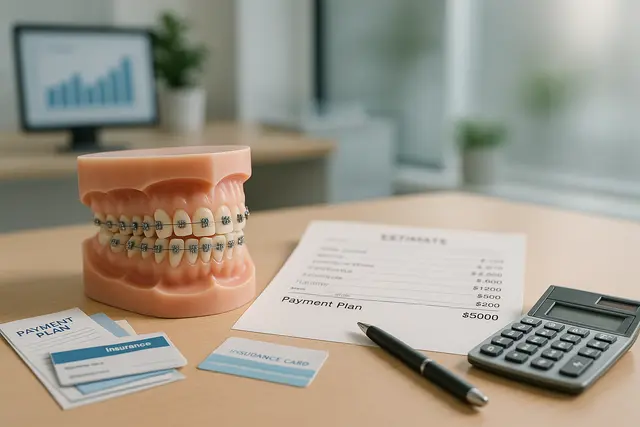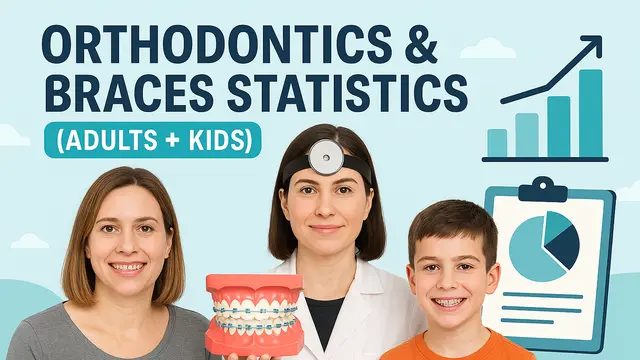Orthodontics
9 min read
Apr 03, 2025
Self-Ligating vs. Traditional Braces: Understanding the Differences
Today, patients typically choose between two main types: traditional braces and self-ligating braces. Both involve wires and brackets, but they differ in how they interact with the archwire and influence factors like comfort, maintenance, and overall efficiency. Understanding these distinctions can help patients make informed decisions about their orthodontic care.

Picture a teenager hiding a shy grin, a busy parent finally treating themselves, or a grand-parent determined to flash a confident smile during every family photo, orthodontic treatment speaks to all of them. Over the last twenty years one buzzword has taken center stage: self-ligating. Your orthodontist mentions it during the very first consultation, and friends who already wear brackets ask, almost conspiratorially, “Are you getting self-ligating braces or sticking with traditional braces?”
That braces-versus debate can feel overwhelming, especially when search engines throw phrases like passive self-ligating, active self-ligating braces, and conventional orthodontic bracket systems at you.
What Is Self-Ligating Orthodontics?
A self-ligating bracket uses a built-in clip or sliding door to secure the arch-wire. No elastic bands or metal ties needed. The design of self-ligating hardware makes each bracket look sleeker, and because opening and shutting self-ligating brackets is quick, adjustment appointments often wrap up before your coffee order even pings.
Using self-ligating technology, orthodontists claim lower friction between brackets and arch-wires, potentially shortening treatment. Whether self-ligating braces truly shave months off every case is still debated, but nobody denies that the absence of ligatures in self-ligating gear makes oral hygiene simpler, you can reach the gumline without wrestling tiny rubber rings.
A Closer Look at Self-Ligating Braces
Self-ligating braces typically come in two flavors, active and passive. Active self-ligating braces feature a clip that presses against the wire, adding a gentle squeeze to help teeth move. Passive self-ligating brackets hold the wire loosely at first, easing pressure on freshly shifted roots.
Both types of self-ligating brackets share the same headline: fewer add-on pieces and a clean profile that many patients find less bulky than conventional brackets. Self-ligating braces stand out in waiting-room chatter because they seem almost futuristic. Remember, though, braces with self-ligating clips still rely on your biology. Bone remodels at its own pace, clip or no clip.
How Traditional Braces Work
Classic, sturdy, time-tested, traditional metal braces remain the workhorse of orthodontics. They use conventional brackets plus elastic bands or metal ties to ligate the wire. Those bright rubber colors? Pure flair on top of function. Conventional braces handle everything from minor crowding to jaw-shifting surgical cases, and your orthodontist may favor them for complex movements that demand heavy, consistent torque. If you worry about aesthetics, ask about lingual braces that hide behind teeth, though they come with their own learning curve.
Braces vs Conventional Braces: What’s in a Name?
A century of research backs conventional appliance systems. Self-ligating appliances burst into mainstream use in the 1990s. The biggest differences between self-ligating and conventional braces lie in fastening method and how they feel during wire changes. Ligatures in self-ligating braces may be nonexistent (because there are none), while conventional brackets rely on colored elastics that can stain after a curry night. A systematic review on self-ligating efficiency found treatment-length differences ranged from zero to a couple of months, hardly deal-breakers for most adults, but kids on a countdown to prom might care.
Self-Ligating Braces vs Conventional Brackets: Key Differences
A comparison of self-ligating and conventional orthodontic bracket designs reveals a lower profile around the gumline for self-ligating models, which many hygienists love. However, plaque scores still rise if patients slack on brushing, braces are a good option only when paired with diligent oral hygiene. On comfort, some wearers report less pain than those with conventional ties during the first week. The real-world takeaway? Pain tolerance varies more between individuals than between bracket styles.
Should You Get Self-Ligating Braces?
Ask yourself three questions: Will shorter chair-time per appointment help my packed schedule? Does my malocclusion suit a low-friction system? And, let’s be real, do I like the look? Your orthodontist can run a digital simulation to show how brackets of self-ligating braces will sit on your teeth. If you’re undecided, book a second opinion; most offices offer complimentary assessments. Using self-ligating braces may make sense if you crave fewer adjustments or struggle with elastic staining. Just remember that braces tend to highlight dietary sins (goodbye popcorn hulls), no matter the clip.
Breaking Down the Cost of Self-Ligating Braces
Money matters. The cost of self-ligating braces often edges a few hundred dollars above conventional braces in the same city because precision clips bump up manufacturing fees. If you catch a special or your insurer loves cutting-edge orthodontics, the gap might shrink. Always request a printed estimate that lists brackets compared to conventional parts, lab fees, and follow-up visits. Some practices bundle retainers; others bill them separately. And don’t forget to ask about repairs, replacing a broken clip can add up.
Self-Ligating Braces Pros and Possible Drawbacks
Self-ligating braces offer several advantages beyond marketing hype. First, the streamlined clip means fewer food traps, which boosts daily brushing scores, cue happier hygienists at your six-month cleaning. Second, active self-ligating braces deliver constant but gentle pressure, possibly easing the “tight-night” soreness many people fear. Third, brackets are smaller and smoother against cheeks. Still, every perk has a flip side: slightly higher prices and fewer color options if you love neon elastics.
Why Some Orthodontists Still Prefer Conventional Braces
Control is the big reason. Need to swing a wayward canine into place? A colorful power chain plus sturdy wire does the trick. Your orthodontist can swap out elastics in endless force combinations, something harder with passive self-ligating clips. Conventional and self-ligating systems both rely on brackets and arch-wires, but conventional brackets grant doctors extra fine-tuning. Plus, kids love picking new colors every visit.
Metal Braces and Other Material Options
Both bracket families can be metal. Self-ligating braces may come in stainless steel or ceramic, just like traditional metal braces, and the shine looks similar at first glance. Metal brackets withstand teenage sports collisions better than their porcelain cousins, and they cost less to produce, so insurance prefers them. Ceramic is less visible but more fragile.
Clearing Up the Term Self Ligating Braces
You’ll find “self-ligating braces,” “self ligating braces,” and even “self-litigating braces” (hello, autocorrect) scattered online. They all describe the same clip-wire system. Don’t panic if a blog leaves out the hyphen.
What Are Ligating Braces?
Traditional appliances sometimes earn the nickname “ligating braces” because they require elastics to ligate the wire. Ligating braces work by exerting targeted pressure through those little colored bands. The bands stretch over time, which is why adjustment schedules are four to six weeks. The presence of elastic bands or metal ties can accelerate plaque buildup; floss threaders become your nightly meditation routine.
Self-Ligating vs Conventional: Lifestyle and Maintenance
Self-ligating braces tend to collect fewer food bits, sparing you an awkward spinach-in-elastic moment. On the flip side, conventional brackets are bulletproof when you need loops, springs, or other fancy auxiliaries. Athletes wearing mouth guards won’t notice much difference, but wind-instrument players often prefer the lower profile of passive self-ligating clips.
What Does It Mean to Ligate the Arch-Wire?
In orthodontics, to ligate is simply to tie the arch-wire to each bracket, either with elastic rings or steel ties. Self-ligating systems skip that extra tie because the clip does it for you, think Velcro instead of shoelaces.
Comparing Costs: Self-Ligating Braces vs Conventional Braces
National surveys place the average fee for conventional appliances around $4 500 to $6 000. The cost of self-ligating braces bumps that by roughly $300 to $600. Financing plans spread the pain, but interest can sneak in. Some clinics bundle whitening or high-tech retainers into self-ligating packages.
Self-Ligating vs Traditional: Which Fits Complex Cases?
When you stack self-ligating against traditional brackets in terms of chair-time, the newer system wins. Yet, for complex skeletal issues, an orthodontist might still pick traditional gear because they’ve mastered those mechanics for decades.
How Ligating Braces Work Day to Day
Ligating braces work through the tug-of-war between stiff wires and elastic ties. Every time you chew, micro-forces shift teeth toward their new homes. Self-ligating braces play the same game, just without the extra elastics.
Oral Hygiene and Lifestyle Tweaks for Any Braces
Good oral hygiene keeps white-spot lesions at bay. Self-ligating braces may grant easier brush angles, yet braces use stubborn trapping zones no matter the clip style. Braces can help straighten teeth, but only you can wield the floss. If you’re a serial snacker, both systems demand extra rinses.
Research Spotlight: Efficacy of Self-Ligating Systems
A 2024 systematic review on self-ligating efficiency analyzed 18 randomized trials. The authors concluded that while the efficacy of self-ligating is “comparable” to conventional brackets, patient preference leaned slightly toward the clip design thanks to shorter appointments. Another paper comparing self-ligating versus conventional twin brackets found negligible differences in root resorption.
Advantages and Disadvantages at a Glance
Self-ligating braces offer slick design, faster wire changes, and reduced elastic staining, clear advantages over conventional ties. Yet some brands are a tad more expensive, and replacement parts can be pricey. Conventional brackets excel in heavy rotational movements and cost less up front but demand meticulous elastic changes.
Passive vs Active Self-Ligating Brackets
Passive self-ligating brackets charm first-time wearers by allowing ultra-thin starter wires that barely crank pressure. Active clips kick in stronger forces once alignment improves. Two types of self-ligating brackets in one treatment sequence let doctors fine-tune pressure like a DJ mixing tracks.
Opening and Shutting Self-Ligating Brackets During Adjustments
During check-ups, you’ll hear a soft click as the doctor opens each clip. Self-ligating brackets close with the same gentle pop, no squeal. Friends in the next bay may still be getting elastics unhooked when you’re already rinsing.
Are Self-Ligating Braces Truly Faster?
Some brands tout finishing cases six months sooner. A fairer claim: self-ligating braces tend to save a few minutes per visit and might trim a handful of weeks off total time in straightforward cases. Complex jaw issues rarely see dramatic speed boosts.
Comfort Levels: Self-Ligating or Conventional?
Patients ask, “Will I feel more pain than those with traditional ties?” Studies swing both ways. One trial showed day-one discomfort scores were similar, another crowned the clip champion. Ice-water rinses and over-the-counter pain relievers help regardless of bracket type.
Can Self-Ligating Brackets Boost Confidence?
Even though brackets are smaller, some adults still shy away from metal. Ceramic self-ligating brackets scratch that aesthetic itch; just know they’re brittle.
Conventional Orthodontic Systems for Complex Corrections
Severe crossbites sometimes need heavy elastics, coil springs, or even headgear. Conventional appliance systems accept these auxiliaries like Swiss-army knives. Self-ligating braces can too, but doctors might need workarounds.
Conventional Wisdom About Brackets and Experience
Dentistry loves tradition for good reason, decades of proof. Ask your provider how many self-ligating appliances they’ve finished versus conventional cases. Experience often trumps marketing.
Braces Are a Good Option at Any Age
Kids, teens, and adults can all benefit. Self-ligating braces offer comfort perks while metal braces deliver unwavering reliability. Either way, braces can help fix crowding, close gaps, and improve bite function.
How Self-Ligating Technology Keeps Getting Smaller
Early clips occasionally jammed; current designs rarely stick. Many brands have refined the mechanism so much that the self-ligating bracket feels smoother than a phone’s volume button.
What Makes Self-Ligating Braces Different From Traditional Braces?
Self-ligating braces use a built-in clip or sliding door to hold the wire in place, eliminating the need for elastic bands. This design often results in easier adjustments, fewer food traps, and potentially shorter appointment times compared to conventional braces with ligatures.
Are Self-Ligating Braces More Comfortable?
Many patients report that self-ligating braces feel smoother and cause less irritation to the cheeks and gums. Because they apply gentler, continuous pressure, some also experience less discomfort during the first few days after adjustments.
Do Self-Ligating Braces Speed Up Treatment Time?
In some cases, self-ligating braces may shorten treatment slightly or reduce appointment duration, but the overall difference is often minimal. Tooth movement still depends on biological factors, so results vary based on the individual case.
Are Self-Ligating Braces Worth the Extra Cost?
Self-ligating braces often cost a few hundred dollars more due to their advanced hardware. However, they may be worth it for patients who want shorter appointments, easier cleaning, and a lower-profile feel, especially if these features align with their lifestyle needs.
Read Next
Related Posts

Orthodontics
Retainer That Looks like Braces: Benefits for Long-Term Alignment
A retainer might not get as much attention as braces, but it plays a crucial role in maintaining your smile after orthodontic treatment. Whether you're new to retainers or curious about the type that looks like braces, understanding their purpose and benefits is key to keeping your teeth aligned for the long haul.
6 min read
Sep 15, 2025

Orthodontics
How Much Are Metal Braces? Cost Comparison With Other Options
Thinking about getting braces but overwhelmed by the cost? You’re not alone. Orthodontic treatment can be a major investment, and understanding the different price points, from metal braces to clear aligners, can help you make a smart, confident decision.
5 min read
Sep 15, 2025

Orthodontics
Orthodontics & Braces Statistics (Adults + Kids)
Orthodontics has transformed from a niche medical service for teenagers into a booming sector that spans all ages. Today, both adults and children seek orthodontic treatment to improve their smiles, fix bite issues, and boost self-confidence.
4 min read
Aug 21, 2025
Don’t have time to research every dentist around you?
See why 30k+ patients trusted us